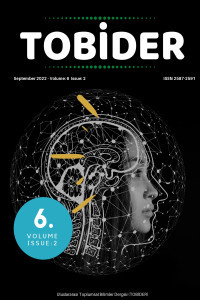ZHUANGZİ HİCİVLERİNİN İÇERİK VE TEKNİK AÇIDAN İNCELENMESİ
Taocu Düşünce, Zhuangzi, Anekdot, Hiciv Sanatı, İroni
A CONTENT AND TECHNICAL ANALYSİS OF ZHUANGZI'S SATIRE
Taoist Thought, Zhuangzi, Anecdote, Satire, Irony,
___
- Bian Jiazhen边 家 珍, Lun Zhuangzi Sanwen De Fenshi Qingxiang Ji Fengci Tese (论庄子散文的愤世倾向及讽刺特色),Wenxue Pinglun Bao, No. 3, 2005, 179-187.
- Kirilen Gürhan, Eski Çin’de Yazın ve Düşünce, Gece Kitaplığı, Ankara 2019.
- Li Mingzhu李明珠, Lun Zhuangzi De Fengci Yishu (论庄子的讽刺艺术), Journal of Anhui Insitute of Education, No 4 Serial No.72, April 1997, 51-54.
- Ma Zhifu马志富, Zhuangzi Sanwen de Fengci Yishu Tedian (庄子散文的讽刺艺术特点 ), Journal of Jinan Vocational College, No.5 Serial No. 63, October 2007, 84-90.
- Unal Chiang Gonca, Zhuangzi’da Özgürlük Düşüncesi: “Özgür Yolculuk” Bölümü Üzerinden Bir İnceleme. Dört Öge, (16), 2019, 47-65.
- Wang Yu 王煜,Zhuanzgi Lun Dao Zhi Chaoyuexing Yu Shixianxing (莊子論道之超越性與實現性), Zhongguo Wenhua Yanjiusuo Xuebao,Volume 6 Issue 1, December 1973, 109-142.
- Zhang Songhui, Zhuangzi Duben, Sanmin Shuju, Taipei 2005.
- Zhou Shufang 周淑舫, Shilun Zhuangzi De Fengci Yuyan (试论庄子的讽刺寓言), Journal of Suihua Teachers College, No. 4, 1992, 11-14.
- Dong Qi董 琦 , Zhuangzi Yuyan Gushi Yishu Tezhi Tanxi (庄子寓言故事艺术特质探析),China Academic Journal Electronic Publishing House, 2017, 43-44. https://scjg.cnki.net/kcms/detail/detail.aspx?filename=DZLU201703045&dbcode=CJFQ&dbname=CJFD2017&v= (Erişim:3.8.2022)
- Shi Ji 史記 (Tarih Kayıtları), Laozi Hanfei Liezhuan. Chinese Text Project: https://ctext.org/shiji/lao-zi-han-fei-lie-zhuan (Erişim:3.8.2022)
- Zhao Xia 赵霞 ( March 2002), Jian Zhe Zhuangzi Yuyan Zhong de Fengci Shoufa de Gaoming Yunyong (简折庄子寓言中的讽刺手法的高明运用), Journal of Beijing Xuanwu Hongqi Spare-time University, doi 8rdxzgl9jl/139801, 24-26. (https://www.chinaqikan.com/thesis/detail/139801(Erişim:3.8.2022)
- Başlangıç: 2017
- Yayıncı: Sadık Hacı
Tuğba ŞİMŞEK, Ali İlker GÜMÜŞELİ
AFTER LİFE DİZİSİNE DİNAMİK BİR BAKIŞ
Bahar AKOĞLU, Pırıl İPEKÇİOĞLU, Kaantan ADAR
ZHUANGZİ HİCİVLERİNİN İÇERİK VE TEKNİK AÇIDAN İNCELENMESİ
TÜRKİYE-ÖZBEKİSTAN İLİŞKİLERİ: STRATEJİK İŞ BİRLİĞİ VE ORTAKLIK
MEKAN VE MÜZİK İLİŞKİSİNDE TEMEL YAKLAŞIMLAR: ETNOGRAFİK ARAŞTIRMALARDA MEKAN
AHMET HAMDİ TANPINAR’IN BEŞ ŞEHİR DENEMESİNDE MİLLÎ KÜLTÜR
KAPTANIDERYA KÜÇÜK HÜSEYİN PAŞA’NIN DENİZ SEFERLERİ (1792-1803)
